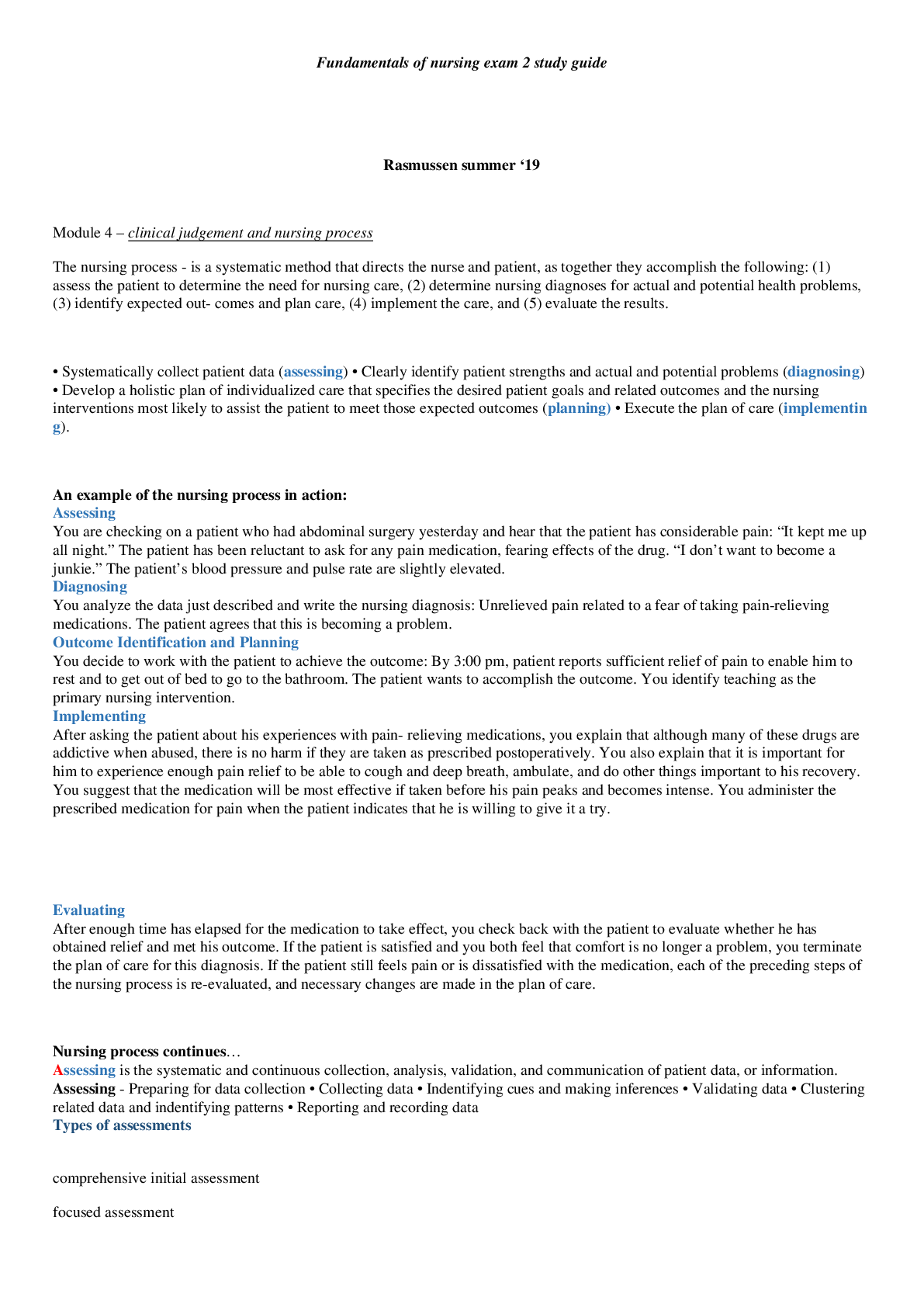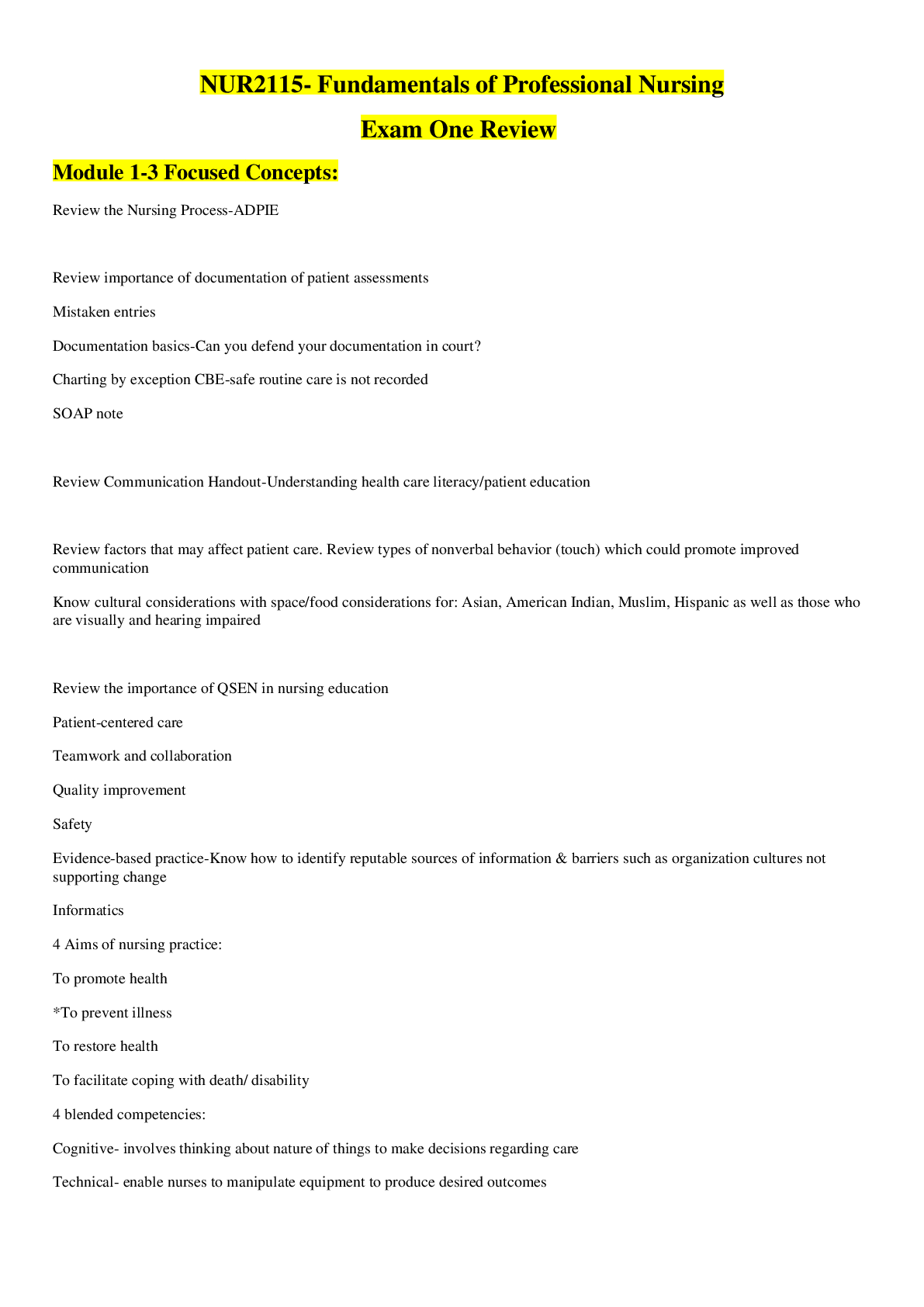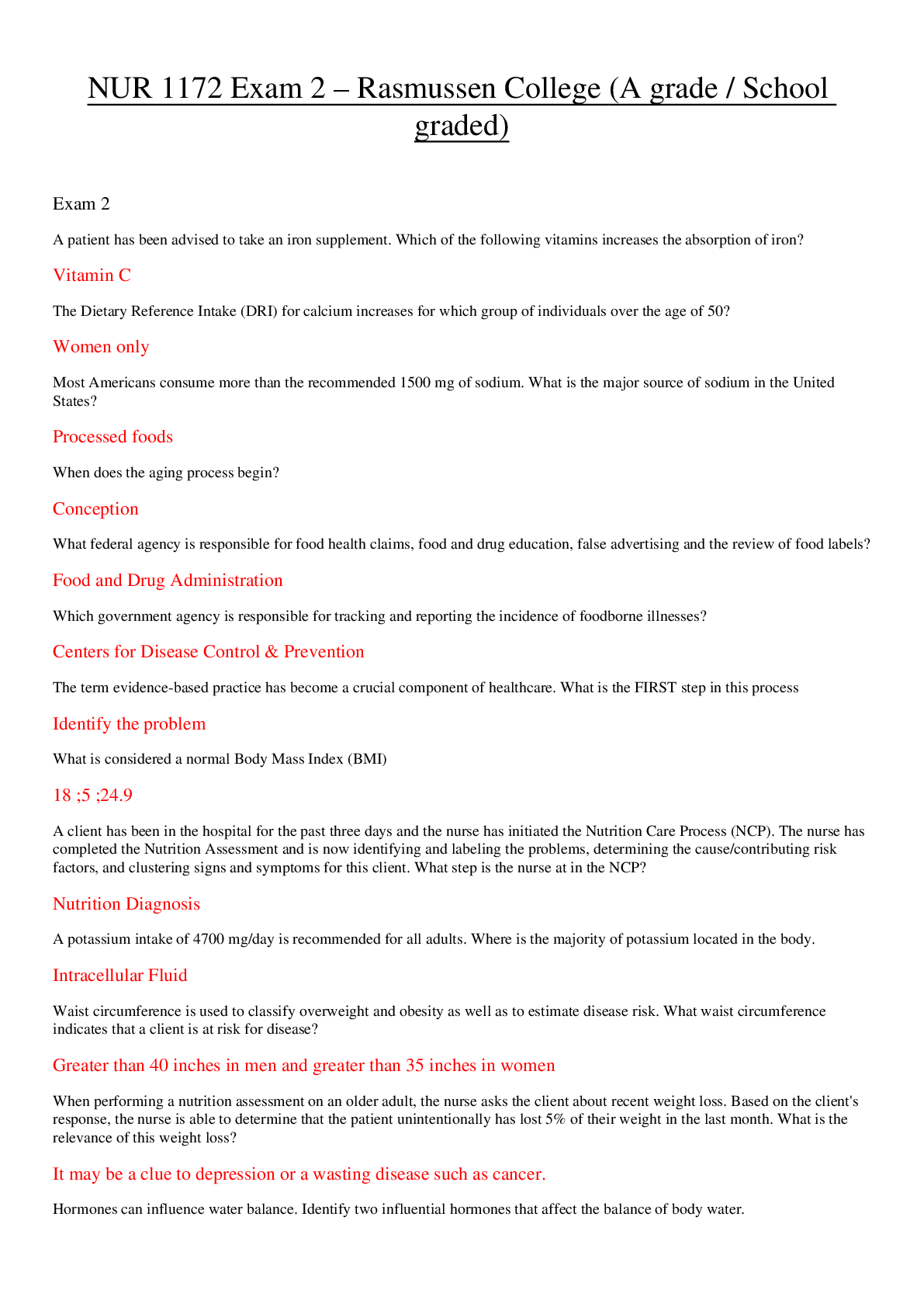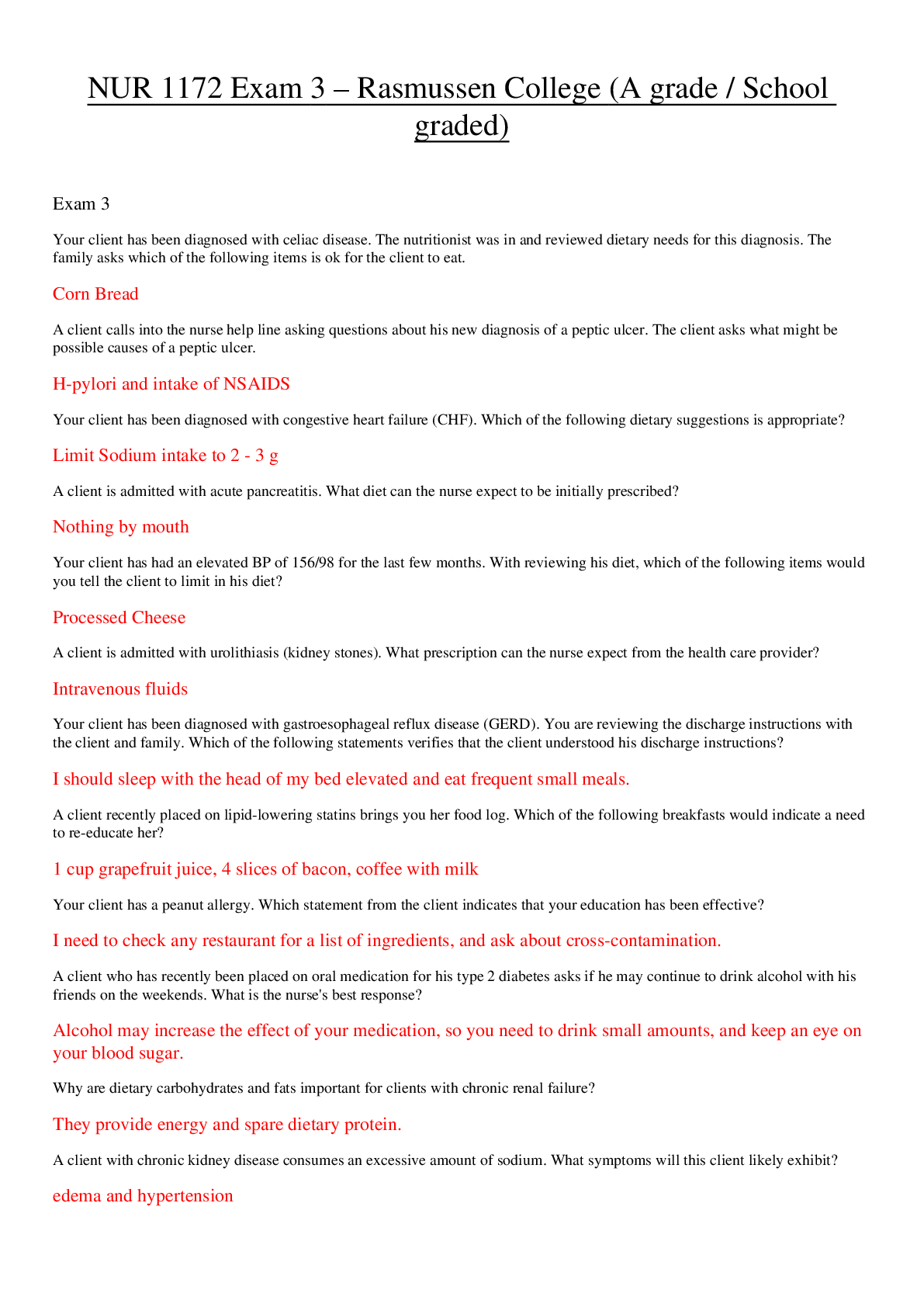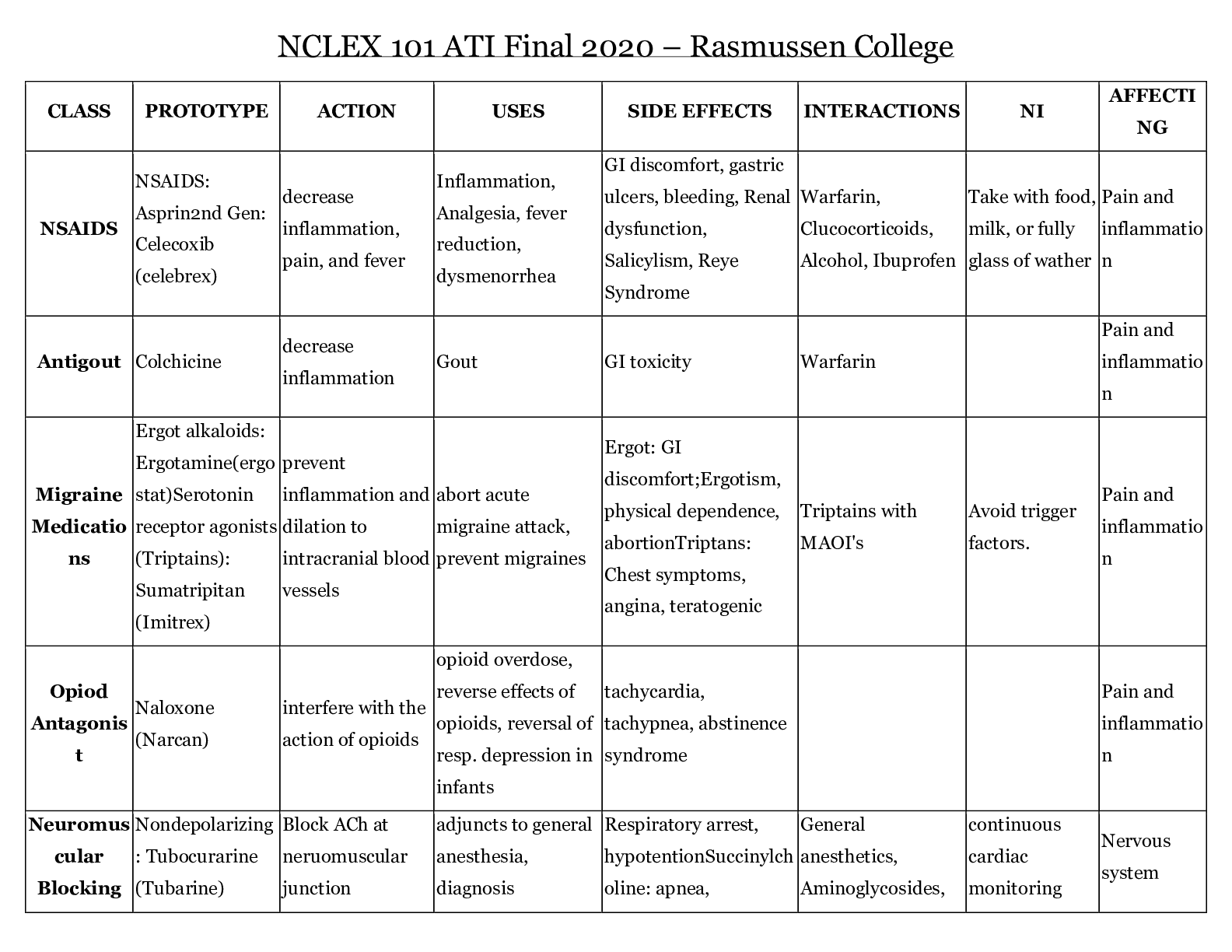*NURSING > EXAM > NUR 2115 - Fundamentals of Professional Nursing Final Exam- Spring 2019 – Rasmussen College | NUR2 (All)
NUR 2115 - Fundamentals of Professional Nursing Final Exam- Spring 2019 – Rasmussen College | NUR2115 - Fundamentals of Professional Nursing Final Exam- Spring 2019
Document Content and Description Below
NUR 2115 - Fundamentals of Professional Nursing Final Exam- Spring 2019 – Rasmussen College __________________________________________________________ *The final exam will cover your required read... ings from the following chapters: 1, 2, 3, 4, 5, 6, 8, 10, 11, 12, 13, 14, 15, 16, 17, 18, 19, 20, 21, 22, 23, 25, 26, 27, 31, 32, 33, 34, 36, 37, 38, 40 and 41. All Modules Review various nursing diagnoses related to specific patient problems Module 1-3 Concepts: Review importance of documentation of patient assessments Accurate documentation of this data is important to provide a baseline for later comparisons as the patient's condition changes.The patient record is the only permanent legal document that details the nurse's interactions with the patient and is the nurse's best defense if a patient or patient surrogate alleges nursing negligence. Review types of nonverbal behavior which could promote improved communication Body language Gestures, movements, touch, appearance, adornments Personal appearance May express culture, religion, group associations, self-concept Posture and gait Erect vs slouched posture Facial expression The most expressive part of the body! Review the importance of QSEN in nursing education To prepare nurses who combine the highest level of scientific knowledge and technologic skill with responsible, caring practice. To challenge students to identify and master the cognitive and technical skills as well as the interpersonal and ethical/legal skills they will need to effectively nurse the patients in their care. Review what a sentinel event is An unexpected occurrence involving death or serious physical or psychological injury, or the risk thereof. Serious injury specifically includes loss of limb or function. An error that causes serious harm to a client and singles out the need for investigation. Review examples of health promotion activities for primary, secondary and tertiary Primary-Directed toward promoting health and preventing the development of disease processes or injury. Ex: Immunization clinics, family planning services, providing poison-control information, accident prevention education, teaching about a healthy diet, health-risk assessments. Secondary-Focus on screening for early detection of disease with prompt diagnosis and treatment. It identifies an illness, reverse or reduce its severity or provide a cure, and thereby return the person to maximum health as quickly as possible. Ex: Assessing children for normal growth and development and encouraging regular medical, dental, and vision examinations; screenings for BP, cholesterol, and skin cancer; routine GYN exams and mammograms; teaching testicular self-exams to men; administering medications; caring for wounds. Tertiary- Begins after an illness is diagnosed and treated, with the goal of reducing disability and helping rehabilitate patients to a maximum level of functioning. Maintaining and preventing progression of severe diseases, dying with dignity, assisting to cope with impending death. Ex: Teaching a diabetic patient how to recognize and prevent complications; using PT to prevent contractures in a patient who has had a stroke or spinal cord injury; referring a woman to a support group after removal of a breast because of cancer. Review use of ISBARR model of communication ISBARR is an easy to remember, concrete mechanism useful for framing any conversation, especially critical ones, requiring a clinician's immediate attention and action. It allows for an easy focused way to set expectations for what will be communicated and how between members of the team, which is essential for developing teamwork and fostering a culture of patient safety. Introduction Situation Background Assessment Recommendation/Request Read-back of orders or Response Review teaching for a patient on anticoagulant therapy- safety considerations Use electric razors to shave Age related safety concerns Infant- Falls, SIDS (must lay on back to sleep), Injury from toys, Burns, Suffocation and choking Electrocution, Ingestion of foreign bodies, Child mistreatment (nurse obliged to report to DCF) **Need rear facing car seat Toddler: Falls Cuts, Drowning, Concussions, Guns and weapons (locked and unloaded), Escape from home Poison (Poison Control # on fridge), Suffocation and choking, Child mistreatment (nurse obliged to report to DCF), **Front facing car seat in the BACK seat School Age Children- Sexual abuse, Burns, Broken bones, Concussions Drowning, Guns and weapons, Use of Internet, Sports injuries (cognitive rest), Abduction, Bullying (cyberbullying), Child mistreatment (nurse obliged to report to DCF) **Back seat until age 13 Teenagers: Piercing & Tattoos, Driving (distracted driving)..texting especially, Firearms, Suicide, Drugs and Alcohol and Tobacco, Sexuality and STIs, Sexual abuse, Use of Internet, Risk taking (diving into unfamiliar water), **Seat belt and driving Adults: Stress, Domestic Violence, MVA, Industrial accidents and exposure, Drugs and alcohol abuse Elderly: Falls #1, Elder abuse and neglect, MVA, Sensorimotor changes, Fires (candles, heaters)..forgetfulness, Burns (electric blankets, hot water, heating pads) Accidental overdosing and polypharmacy Developmental theories: focus on Erickson’s Trust vs. mistrust (infancy) Autonomy vs. shame and doubt (toddler) Initiative vs. guilt (preschool) Industry vs. inferiority (school age) Identity vs. role confusion (adolescence) Intimacy vs. isolation (young adulthood) Generativity vs. stagnation (middle adulthood) Ego integrity vs. despair (later adulthood) Musculoskeletal: Review education on crutch walking Education: Remind the patient that the support of body weight should come primarily on the hands and arms while using the crutches, not in the axillary areas, where pressure may damage nerves and cut off circulation. Also, the crutches should not be forced into the axillae each time the body moves forward. Positioning-Prevent pressure on the axillae. Keep elbows close to sides. Prevent crutches from getting closer than 12 inches to your feet. To rise for a chair with crutches-Slide forward to the edge of the chair. Extend the injured leg to prevent any weight bearing. Place crutches on unaffected side, lean forward, and push off using the crutches. - - - - - - - - - - - - - - - - - - - - - - - - - - - - - Gastrointestinal: ¬ Review the complete assessment of the GI system including inspection, auscultation, palpation and percussion ¬ Review conditions of diarrhea and constipation and precipitating factors of each ¬ Review the components in a GI assessment ¬ Review risks and treatments for constipation ¬ Review effects of the GI system on immobility ¬ Review the risk factors which increase irritable bowel syndrome (IBS) ¬ Review diagnostic colon cancer screening ¬ Review education and teaching regarding ostomy care ¬ Review side effects of diarrhea ¬ Review teaching regarding a patient undergoing a colonoscopy Genitourinary: ¬ Review the components of performing a GU assess ¬ Review s/s of UTI, risks for developing UTI and treatments ¬ Review the effects of immobility on the GU system ¬ Review causes of urinary incontinence ¬ Review the GU terminology: micturition, oliguria, dysuria, retention, urgency ¬ Review nursing care for urinary incontinence ¬ Review the process of obtaining a 24 hour urine collection ¬ Review the collection of a midstream urine specimen Pain: ¬ Review the effects that severe/uncontrolled pain has on VS ¬ Review the types of pain: chronic, acute, intractable, neuropathic, radiating, phantom, referred psychogenic ¬ Review which pain management tasks can be delegated to nursing assistant ¬ Review alternative techniques of pain management: hypnosis, distraction, guided imagery, massage, reiki, music, aromatherapy ¬ Review risks of inadequate pain management [Show More]
Last updated: 1 year ago
Preview 1 out of 17 pages
Instant download
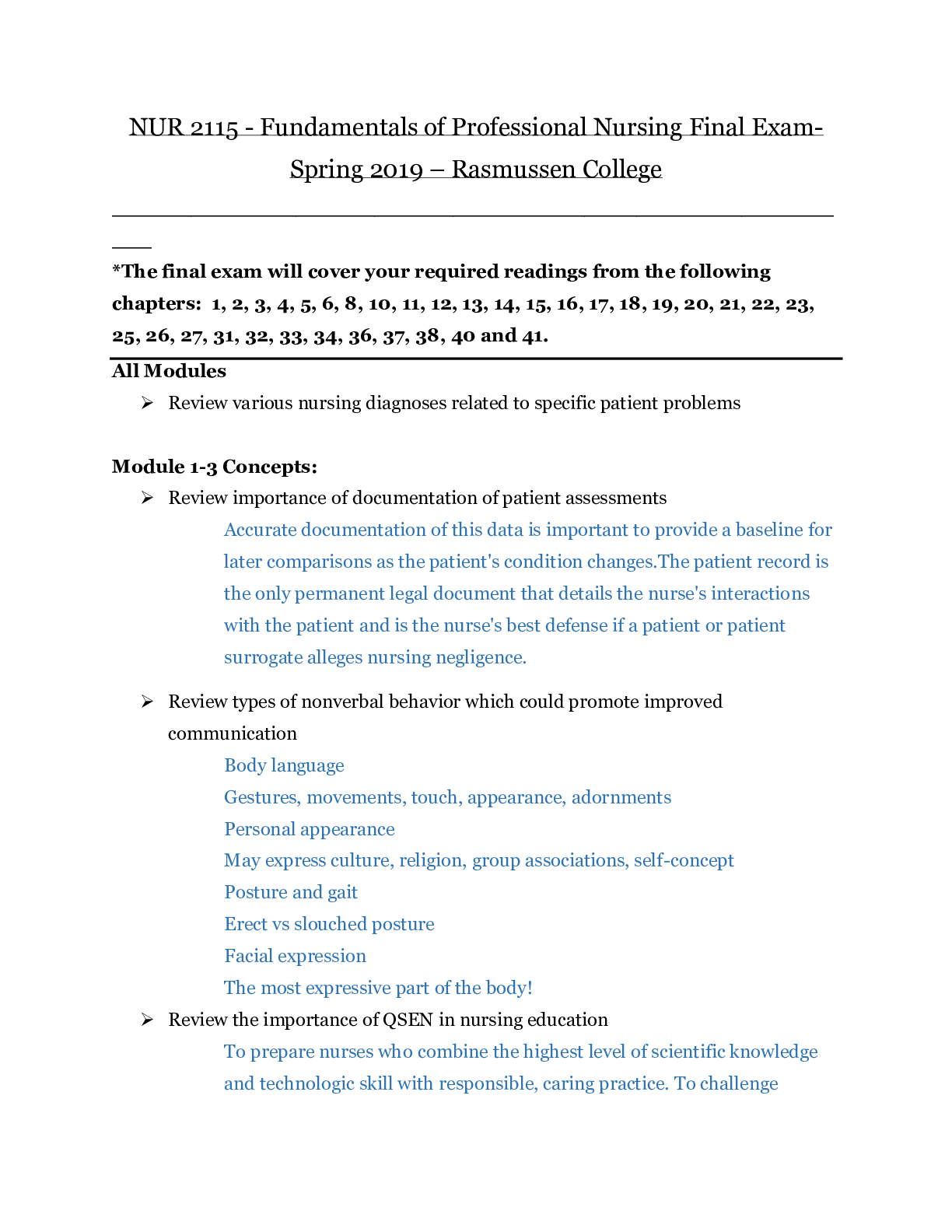
Buy this document to get the full access instantly
Instant Download Access after purchase
Add to cartInstant download
Reviews( 0 )
Document information
Connected school, study & course
About the document
Uploaded On
Jul 13, 2020
Number of pages
17
Written in
Additional information
This document has been written for:
Uploaded
Jul 13, 2020
Downloads
0
Views
39














